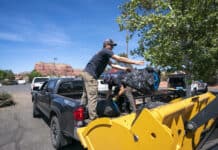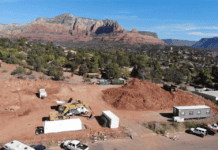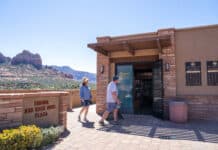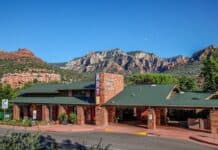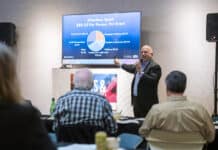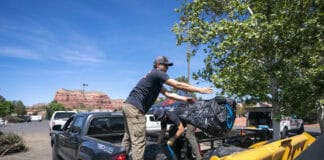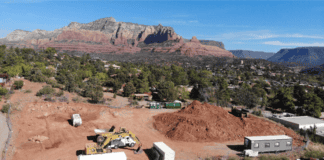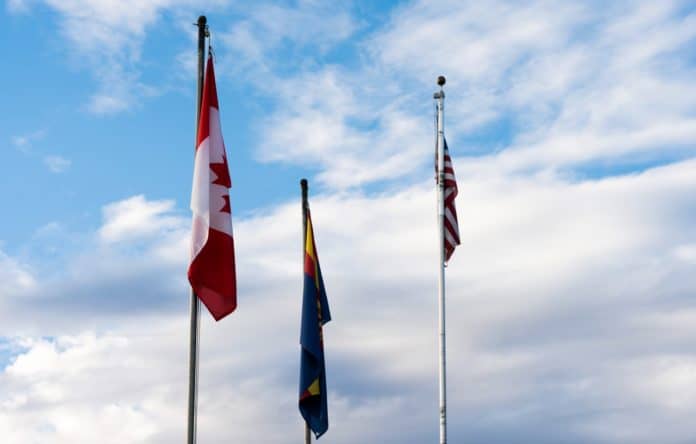
On Nov. 8, the U.S. reopened its borders to vaccinated tourists from 33 countries previously barred from non-essential travel to the country due to the pandemic.
Will international tourists now flock back to Sedona, adding once again the notes of many languages to the streets and restaurants of the city?
Sedona tourism leaders say not in the immediate future. The loosening of international travel restrictions is a first step, but Sedona Chamber of Commerce leaders don’t see the change bringing large numbers of international travelers back to Sedona right away — and that’s OK, as domestic visitation is still up and employers are wrestling with pressing issues like lack of workforce housing.
Getting Back to the States
Prospective international tourists to the U.S. currently face extra rules and red tape to travel — from the U.S. government and their own — and the commercial airline industry is only gradually recovering as it struggles with pandemic-related challenges. COVID-19 transmission rates also remain high in many parts of the U.S.
Before the pandemic, foreign nationals accounted for 20% to 23% of visitors to Sedona. That changed quickly beginning in 2020 as a series of executive orders by the Trump and Biden administrations barred non-essential travel from many counties, slamming the door on some of the biggest sources of tourists to the U.S. and Sedona, including Canada, Japan, the United Kingdom and Germany, among others.
Now, tourists from all of those previously barred countries are free to return to Sedona — at least in theory. One business Sedona Red Rock News reached out to, Sedona ATV, reported an uptick in international customers after the change.
“We have seen visitors from Spain, Canada, Switzerland and Germany so far since they have opened up,” Sedona ATV manager Brian Carstens wrote in an email. “Glad to see them back.”
Other businesses, including Enchantment Resort and helicopter tour company Guidance Air said they haven’t seen an influx of international travelers yet.
Sachiko Sado, director of tourism development at the Sedona Chamber of Commerce, said she’s receiving more inquiries from international tour companies now that restrictions have been relaxed, but she hasn’t seen these translate into bookings yet.
She called the loosening of restrictions a “huge step forward” and expects to start spending more time working with international companies in the future, but she doesn’t foresee an immediate impact on the local tourism landscape.
One reason she cited was the slow recovery of commercial air travel.
“There are a lot of issues going on in the airlines,” Sado said. “Flightwise, a lot of airlines decreased their flights and are gradually increasing.”
Sado gained first-hand experience with the current challenges of air travel when she attended Brand USA Travel Week in London at the end of October — her first time traveling internationally since the start of the pandemic. The first leg of her flight was delayed then canceled, along with about 1,500 other flights that day. She had to be rescheduled for a flight the next day through a different city. She eventually made it to London, a day later than expected.
Sado also pointed to rules for foreign nationals returning to their home countries as another factor that might limit foreign travelers for now.
Japan, for example, requires all travelers arriving from overseas, including its own nationals, to quarantine for 10 days after returning. They also need to show a recent negative COVID-19 test to re-enter and again at the end of their quarantine period. That’s in addition to the U.S. government’s requirement for a negative COVID test for tourists from anywhere except Canada and Mexico, in addition to proof of vaccination. Sado said the prospect of a quarantine period at the end of their vacation might cause prospective Japanese tourists to think twice before booking a trip to the U.S.
Chamber President and CEO Candace Carr Strauss pointed out that getting a COVID test is not always easy, with rural areas like Northern Arizona presenting even greater logistical challenges for travelers than urban destinations. Canada just recently dropped a requirement that citizens returning from visits to the U.S. show a negative PCR or other “molecular test” before re-entering the country.
If international tourists don’t rush back to Sedona, that will probably not be a huge blow to the local tourism industry. Carr Strauss said Sedona has fared better than other destinations in the U.S. as domestic travelers clamored for outdoor destinations. She believes this wave of domestic demand is still unfolding. Americans who had difficulty traveling during the pandemic are still planning long-delayed vacations within the U.S., and for many of them, Sedona is on the itinerary.
Carr Strauss is pleased with the reopening of U.S. borders to international tourists, but she’s staying focused on big issues like “the crisis of staffing” that Sedona employers are currently facing and the housing problem that employees are struggling with.
But Carr Strauss and Sado are looking forward to international tourism returning, and not just for the cultural richness world travelers bring. Based on the chamber’s research, international travelers are more likely than domestic travelers to stay longer, spend more on retail and engage in managed visitation, like organized tours and bus travel, which has a lower impact on local resources.


